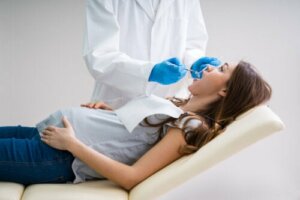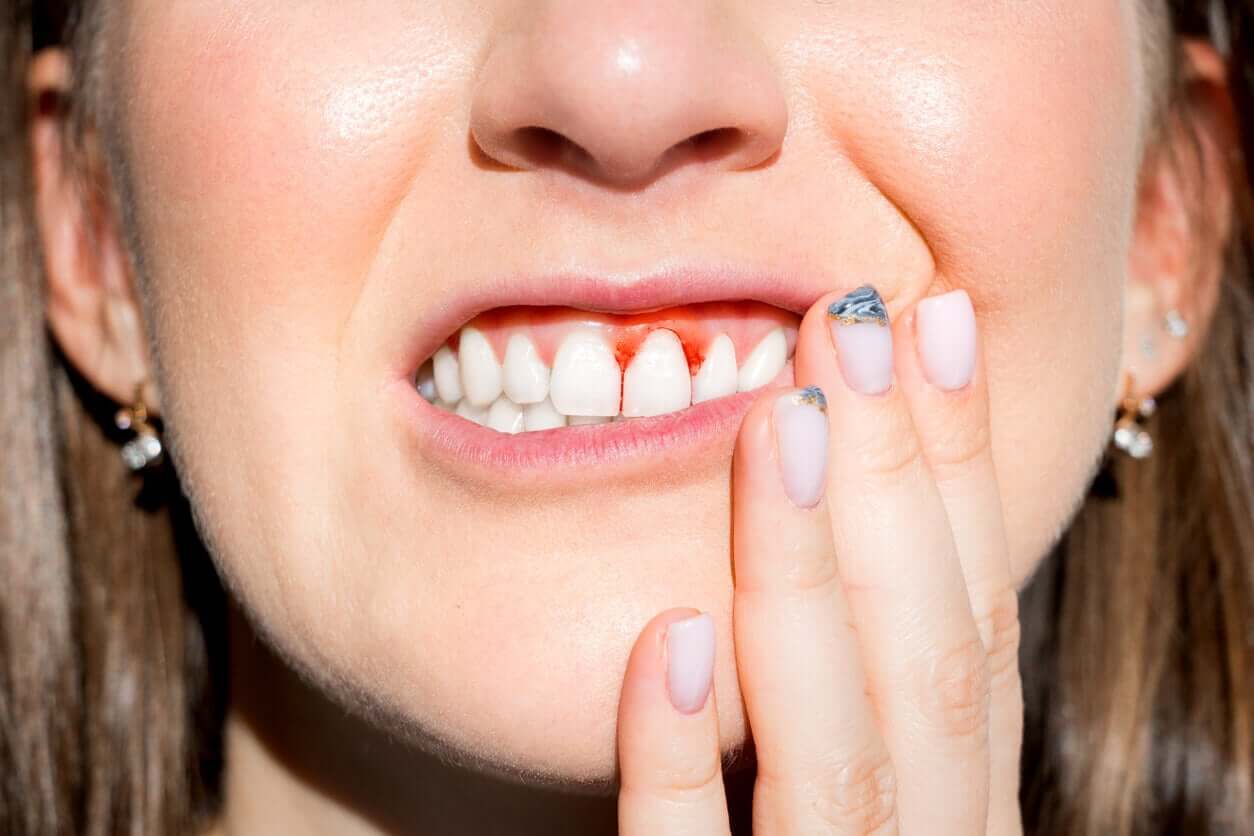How the Oral Health of Mothers Affects Their Babies

Thanks to research and scientific studies, today we know that the oral health of mothers affects their unborn babies. However, many families aren’t really aware of the risks involved.
It’s true that various factors are obstacles for pregnant women when it comes to carrying out correct oral hygiene. For example, morning sickness, tiredness, cravings, altered sleep schedules. All these circumstances can decrease the frequency of brushing or the duration of it.
But it’s also true that, once the baby is born, there is a risk of vertical transmission. That is, bacteria from the mother’s mouth can pass into the baby’s mouth and promote the early development of cavities.
In this article, we’ll discuss this issue and much more in detail. Keep reading!
The poor oral health of mothers can cause early labor
If a pregnant woman neglects her oral hygiene, she puts the development of the fetus that grows in her womb at risk.
Although some women consider it a minor habit and fall into carelessness regarding oral hygiene, the use of a toothbrush and dental floss can make all the difference when it comes to carrying out a healthy pregnancy.
In this sense, a particularly serious situation is premature delivery, which is the anticipated birth of the baby (before the 37th week of gestation).
If the pregnant woman has periodontal disease, she has a higher risk of developing preterm labor. This pathology, also known as pyorrhea or periodontitis, is a chronic condition in which the supporting tissues of the teeth are progressively destroyed.
The initial phase is gingivitis, which is the inflammation of the gums due to the accumulation of bacterial plaque and tartar. When gingivitis isn’t treated correctly, the next step is periodontitis.
A pregnant woman with gingivitis or periodontitis runs the risk that her pregnancy won’t reach full term. Therefore, the baby may not complete their development and suffer completely avoidable consequences regarding their health.
Unfortunately, gingivitis is very common among pregnant women, and therefore, it’s essential to prevent it and treat it in a timely manner when it appears.

The poor oral health of mothers could affect the weight of their babies
Experts believe that there’s a causal association between the presence of periodontal disease in mothers and the low birth weight of their babies. This could be linked to early birth, as in the last trimester (even more so, in the last month) babies go through the fattening stage. In any case, this relationship hasn’t yet been fully established, as there are other studies that haven’t been able to verify it.
Even so, what we do know is that when the mother goes through an inflammatory or infectious process, certain substances cross the placenta and reach the baby.
This can interrupt the normal development of the fetus, especially in the first trimesters, and lead to congenital diseases of various kinds. In addition, these inflammatory substances can trigger premature labor, as they’re mostly prostaglandins.
Finally, a child with low birth weight is at a disadvantage in coping with birth, as this increases the risk of dystocic (difficult) deliveries and perinatal complications.
Therefore, any measure that’s taken to reduce inflammation in the mother’s mouth will be beneficial to the baby. And this includes oral health care.
Mothers with poor oral health transmit bacteria to their baby’s mouth
Mothers and any other adult can pass bacteria to the newborn and this constitutes a type of vertical transmission. In other words, the poor oral health of mothers has a direct impact on the oral health of their children.
The oral cavity of the young child has very little presence of bacteria and is colonized by contact with the outside world. Therefore, the mother can transmit Streptococcus mutans from her mouth to her baby’s mouth. This usually occurs in a specific period of time, called the infectivity window, which is between 6 and 30 months of the infant’s life.
This bacterium is part of the factors responsible for tooth decay. If on top of this, you add harmful eating habits and poor oral hygiene, the possibility of developing early cavities in babies’ teeth is high.
It’s important to note that cavities aren’t a traditional infectious disease and that vertical transmission seems to be the first step towards their appearance in young children. The longer this passage is delayed, the more likely the child will have good oral health.
What to do to take care of the oral health of mothers during pregnancy?

Taking care of the oral health of the pregnant woman is key to avoiding complications in childbirth and to reducing the risk of cavities in the baby. In other words, the prevention of oral problems in children begins during pregnancy.
Here are some tips to prevent the mother’s oral health from affecting the baby:
- Brush your teeth at least 2 times a day: If you’re experiencing nausea, modify brushing times or change toothpaste to avoid the unpleasant sensation. But it’s essential that you don’t give up the habit.
- Use dental floss: It’s important that this method complements brushing to access hard-to-reach dental areas.
- Use fluoride toothpaste: This mineral is able to act on tooth enamel and prevent cavities.
- Follow a healthy diet: Good nutrition during pregnancy is vital in many ways. At the oral level, the limitation of simple sugars reduces the risk of suffering from numerous oral pathologies.
Complying with the recommended dental check-ups for pregnant women is also of utmost importance. With the help of a professional, you’ll be able to discuss any possible doubts and protect your own mouth and that of your baby.
Thanks to research and scientific studies, today we know that the oral health of mothers affects their unborn babies. However, many families aren’t really aware of the risks involved.
It’s true that various factors are obstacles for pregnant women when it comes to carrying out correct oral hygiene. For example, morning sickness, tiredness, cravings, altered sleep schedules. All these circumstances can decrease the frequency of brushing or the duration of it.
But it’s also true that, once the baby is born, there is a risk of vertical transmission. That is, bacteria from the mother’s mouth can pass into the baby’s mouth and promote the early development of cavities.
In this article, we’ll discuss this issue and much more in detail. Keep reading!
The poor oral health of mothers can cause early labor
If a pregnant woman neglects her oral hygiene, she puts the development of the fetus that grows in her womb at risk.
Although some women consider it a minor habit and fall into carelessness regarding oral hygiene, the use of a toothbrush and dental floss can make all the difference when it comes to carrying out a healthy pregnancy.
In this sense, a particularly serious situation is premature delivery, which is the anticipated birth of the baby (before the 37th week of gestation).
If the pregnant woman has periodontal disease, she has a higher risk of developing preterm labor. This pathology, also known as pyorrhea or periodontitis, is a chronic condition in which the supporting tissues of the teeth are progressively destroyed.
The initial phase is gingivitis, which is the inflammation of the gums due to the accumulation of bacterial plaque and tartar. When gingivitis isn’t treated correctly, the next step is periodontitis.
A pregnant woman with gingivitis or periodontitis runs the risk that her pregnancy won’t reach full term. Therefore, the baby may not complete their development and suffer completely avoidable consequences regarding their health.
Unfortunately, gingivitis is very common among pregnant women, and therefore, it’s essential to prevent it and treat it in a timely manner when it appears.

The poor oral health of mothers could affect the weight of their babies
Experts believe that there’s a causal association between the presence of periodontal disease in mothers and the low birth weight of their babies. This could be linked to early birth, as in the last trimester (even more so, in the last month) babies go through the fattening stage. In any case, this relationship hasn’t yet been fully established, as there are other studies that haven’t been able to verify it.
Even so, what we do know is that when the mother goes through an inflammatory or infectious process, certain substances cross the placenta and reach the baby.
This can interrupt the normal development of the fetus, especially in the first trimesters, and lead to congenital diseases of various kinds. In addition, these inflammatory substances can trigger premature labor, as they’re mostly prostaglandins.
Finally, a child with low birth weight is at a disadvantage in coping with birth, as this increases the risk of dystocic (difficult) deliveries and perinatal complications.
Therefore, any measure that’s taken to reduce inflammation in the mother’s mouth will be beneficial to the baby. And this includes oral health care.
Mothers with poor oral health transmit bacteria to their baby’s mouth
Mothers and any other adult can pass bacteria to the newborn and this constitutes a type of vertical transmission. In other words, the poor oral health of mothers has a direct impact on the oral health of their children.
The oral cavity of the young child has very little presence of bacteria and is colonized by contact with the outside world. Therefore, the mother can transmit Streptococcus mutans from her mouth to her baby’s mouth. This usually occurs in a specific period of time, called the infectivity window, which is between 6 and 30 months of the infant’s life.
This bacterium is part of the factors responsible for tooth decay. If on top of this, you add harmful eating habits and poor oral hygiene, the possibility of developing early cavities in babies’ teeth is high.
It’s important to note that cavities aren’t a traditional infectious disease and that vertical transmission seems to be the first step towards their appearance in young children. The longer this passage is delayed, the more likely the child will have good oral health.
What to do to take care of the oral health of mothers during pregnancy?

Taking care of the oral health of the pregnant woman is key to avoiding complications in childbirth and to reducing the risk of cavities in the baby. In other words, the prevention of oral problems in children begins during pregnancy.
Here are some tips to prevent the mother’s oral health from affecting the baby:
- Brush your teeth at least 2 times a day: If you’re experiencing nausea, modify brushing times or change toothpaste to avoid the unpleasant sensation. But it’s essential that you don’t give up the habit.
- Use dental floss: It’s important that this method complements brushing to access hard-to-reach dental areas.
- Use fluoride toothpaste: This mineral is able to act on tooth enamel and prevent cavities.
- Follow a healthy diet: Good nutrition during pregnancy is vital in many ways. At the oral level, the limitation of simple sugars reduces the risk of suffering from numerous oral pathologies.
Complying with the recommended dental check-ups for pregnant women is also of utmost importance. With the help of a professional, you’ll be able to discuss any possible doubts and protect your own mouth and that of your baby.
All cited sources were thoroughly reviewed by our team to ensure their quality, reliability, currency, and validity. The bibliography of this article was considered reliable and of academic or scientific accuracy.
- Flores, J., Oteo, A., Mateos, L., & Bascones, A. (2004). Relación entre enfermedad periodontal y parto prematuro. Bajo peso al nacimiento: una revisión de la literatura. Avances en Periodoncia e Implantología Oral, 16(2), 93-105.
- Stadler, A. F., de Mendonça Invernici, M., Nicolau, G. V., Amenabar, J. M., & Martins, M. C. (2012). La enfermedad periodontal como un factor de riesgo de parto prematuro y bajo peso al nacer-Revisión de la literatura. Acta odontológica venezolana, 50(1), 51-52.
- Martínez Malavé, L., Salazar, C. R., & Ramírez de Sánchez, G. (2001). Estrato social y prevalencia de gingivitis en gestantes. Estado Yaracuy, Municipio San Felipe. Acta odontológica venezolana, 39(1), 19-27.
- Castaldi, J. L., Bertin, M. S., Giménez, F., & Roberto, L. (2006). Enfermedad periodontal:¿ es factor de riesgo para parto pretérmino, bajo peso al nacer o preeclampsia?. Revista Panamericana de Salud Pública, 19, 253-258.
- Dasanayake, A. P., Boyd, D., Madianos, P. N., Offenbacher, S., & Hills, E. (2001). The association between Porphyromonas gingivalis‐specific maternal serum IgG and low birth weight. Journal of periodontology, 72(11), 1491-1497.
- Rojas, F. S., & Echeverría, L. S. (2014). Caries temprana de infancia:¿ enfermedad infecciosa?. Revista Médica Clínica Las Condes, 25(3), 581-587.
- Barzallo Cruz, M. S. (2020). Estreptococos mutans y caries dental en niños de 1 a 3 años de edad (Bachelor’s thesis, Universidad de Guayaquil. Facultad Piloto de Odontología).
- Catarí, P., Portocarrero, G., Hoffmann, I., & Ojeda, F. (2019). Prácticas Preventivas dentro de la Ventana de Infectividad dental por parte de madres lactantes, pacientes del Hospital Universitario Angel Larralde, en Carabobo, Venezuela. Revista de Odontopediatría Latinoamericana, 9(2), 13-13.
- Karletto Korber, F. P., Cornejo, L. S., & Giménez, M. G. (2005). Early acquisition of Streptococcus mutans for children. Acta odontol. latinoam, 69-74.
- Candina, H. J. R., Batista, A. J. H., & Fonte, E. T. P. (2018). Enfermedad periodontal en gestantes del primer y tercer trimestre del embarazo. Revista Cubana de Investigaciones Biomédicas, 37(2), 18-26.
- Hernández, M. J. (2020). Enfermedad periodontal durante el embarazo. REVISTA MEXICANA DE MEDICINA FORENSE Y CIENCIAS DE LA SALUD, 5(3 sup).
This text is provided for informational purposes only and does not replace consultation with a professional. If in doubt, consult your specialist.








